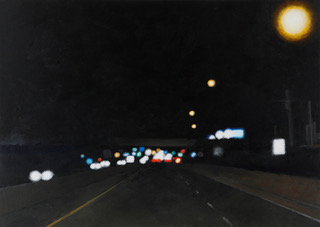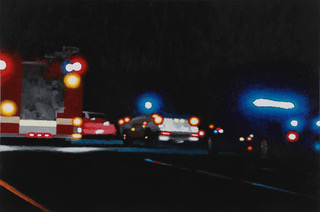A photograph of Caroline Waite in her studio.
"One Small Planet" by Caroline Waite, 10x11x2.5in, tin, paper mache, gouache paintings, model trees, globe, chain. $950 | BUY NOW
Objects are memory in Caroline Waite’s work. Trained as a Printmaker and with experience in Textiles, it should come as no surprise that, when she found herself developing three-dimensional work, the constructions would include repetition. Patterns can be discovered in the recurrence of the objects themselves, culled from her ever-expanding collection (artists were recycling long before it was fashionable or essential), or an even more fundamental echoing of motifs or design elements within the structure of a piece.
“Things are displayed in my studio, either pinned to the wall or arranged on a surface and eventually a dialogue begins. Once I recognize the potential relationship between these objects, a narrative develops and I get to work.
I love the element of mystery surrounding old objects – the questions as to their meaning, their origin and age – in other words, their “secret lives”.”
In England, Waite taught at Northbrook College, Sussex North East Wales University Telford College, Shropshire. Since moving to the U.S. in 2001, she has lived in Texas and New Mexico but prefers her current home of Louisville, even if two house moves in two years has meant little time for involvement in exhibitions:
"Beauty Beckons" by Caroline Waite, 24x12x2in, forged steel, vintage drafting tools, Nymphenburg German porcelain hand, hand painted panel and various mixed media, $1700 | BUY NOW
“However, new work has been in production with exciting developments including a collaboration with a metal fabricator on forged, steel pieces, allowing me to pursue an interest in wall sculptures.” In an interview on PUBLIC, Waite talked about how the intimacy of her work seems in contrast to the American taste for scale. Perhaps this burgeoning interest in developing larger work is a sign that time in the States is exerting some influence on her.
Waite is currently exhibiting with Tom Pfannerstill at Galerie Hertz in Louisville, Kentucky through December 31, 2016, and she will be participating in Strange Worlds: The Vision of Angela Carter, a major invitational exhibit at the Royal West of England Academy, Bristol, England, that opens on December 9, 2016.
Hometown: Cookham Dean, England
Age: 57
Education: BA, Honors in Fine Art, Cheltenham College of Art; Art Teaching Degree, Brighton Polytechnic
Gallery Representation: Galerie Hertz (Louisville)
Website: http://carolinewaite.com
"'Sphinx' (detail)" by Caroline Waite, 14x12x2.5in, antique doll, paper collage, wire in antique repurposed frame, $600 | BUY NOW
"Scene Unseen" by Caroline Waite, 24x12x2.5in, forged steel, carved ivory panels, painted panels, vintage drafting tools and other mixed media, $1600 | BUY NOW
"'Miraculous Discoveries" by Caroline Waite, 38x27x3in, large display case of hand constructed and collaged insects (sourced from detailed photographs of preserved insects), dolls eyes, card stock, wire, and magazine paper, $5500 | BUY NOW
Are you interested in being on Artebella? Click here to learn more.
Written by Keith Waits. Entire contents copyright © 2016 Louisville Visual Art. All rights reserved.
Interested in advertising on Artebella? Click here for more information.








































